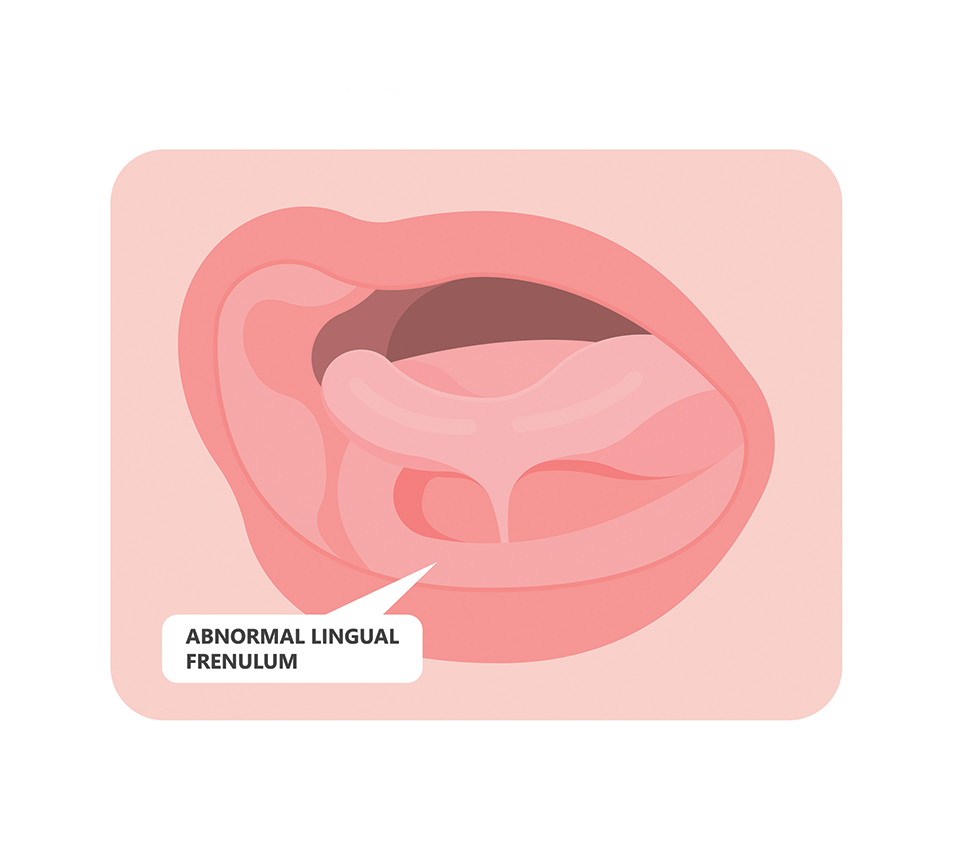Tongue tie surgery
Book a 30 minute consultation to start your treatment plan.
Or call: +65 6734 9393

Tongue tie release and relief
The tongue is an organ that plays an important part in our daily lives. Swallowing, eating, and speaking all require the work of the tongue muscles. A tongue tie is a clinical situation that occurs when the lingual frenum, a piece of soft tissue on the underside of the tongue, is attached very near or at the tip of the tongue. You may feel some restriction in the movement of the tongue especially in extending the tongue outwards. This may affect speech to a certain extent and also cause some discomfort.
Not sure if you or your loved one is experiencing tongue tie symptoms? Book a consultation with our specialists to know if tongue tie surgery is absolutely necessary.

What is a tongue tie?
Normally, the tongue is loosely attached to the base of the mouth with a piece of skin called the lingual frenulum. In individuals with tongue-tie, this piece of skin is unusually short and tight, restricting the tongue’s movement
What can you expect during a tongue tie treatment?
Our dental specialist/ dentist will find out the details of your medical and dental history, go through a consultation and examination and take a digital X-ray of your teeth to enable a thorough and detailed diagnosis.
Thereafter our dentists will discuss with you to recommend the most appropriate solution for your needs
The correction of a tongue tie condition is a simple minor oral surgical procedure performed under local anaesthesia. In the case of young children between the ages of 2 to 6 years old, it is generally recommended for the procedure to be performed under general anaesthesia.
During the procedure, our dental specialist/ dentist will remove the soft tissue (lingual frenum) with a surgical blade, electric knife or laser. The surgical site will then be closed with resorbable sutures and a pressure pack applied.
This procedure takes about an hour to complete.
Under local anaesthesia, the operation site will be numb for about 6 to 8 hours. During this time, go on a soft diet and stay away from hot foods/ drinks. Cold soothing foods like ice cream is recommended. You will be able to resume a normal diet from the second day onwards. You can resume other normal daily activities almost immediately.
If the procedure is performed under intravenous sedation, rest on the day of the procedure is recommended before resuming normal activities on the second day.
Post-surgery, you may experience some facial swelling or pain. There may also be some blood oozing from the wound during the first few days. If bleeding occurs, apply clean folded gauze to the wound and bite on it firmly for 5 minutes. If you taste blood, swallow instead of spitting it out. Rinsing or spitting during the initial 24 hours after surgery will disturb the wound and cause more bleeding. Frequent gauze change or frequent mouth rinsing disrupts the blood clotting process and promotes bleeding. Pressure gauze pack change should be done at 30 minutes intervals, if necessary.
1 day after surgery, rinse the mouth gently with an antiseptic mouthwash or with warm salt water after meals, and before going to bed.
Tongue tie surgery fees
Wondering if Medisave can be used for this procedure?
Yes you can, if you are a Singaporean or a permanent resident of Singapore, Medisave may be utilised to partially cover the applicable fees for tongue tie surgery. The amount ranges based on the complexity of the surgery and the final amount covered will be decided by the CPF Board.
For more details on Medisave coverage, please visit our Medisave Page.
Other fees
For sedation; there will be an additional fee for an Anaesthesiologist to administer the sedation, which is about SGD$900 – SGD$1,000 per hour.
For general anaesthesia, besides the fees for an Anaesthesiologist, operating theatre costs and admissions cost into the hospital may be incurred.
Meet our dental specialists in Singapore
Our fully trained team is dedicated to keeping timely and painless care of your teeth.
Frequently asked questions
How to tell if my child has tongue tie?
Some of the signs that your baby might have tongue-tie includes:
– Having difficulty to latch on the breast or latching for a full feed
– Long feeding time with short breaks in between
– Always seem to be hungry and be unsettled
– Gaining weight at a slower pace
– Clicking sound as they feed
Other signs of tongue-tie that may be found in older children or even adults include:
– Heart-shaped looking tip of tongue when sticking out
– Unable to reach the roof of their mouth or further than the edge of their lower lip with the tip of tongue
– Difficulty moving tongue sideways
What are the different types of tongue tie surgery?
A quick, simple procedure with minimal discomfort named frenectomy is done where the lingual frenulum is freed using sterile scissors or a laser.
For newborns, the procedure is carried out in a day surgery centre, and anaesthesia may not be required. Breastfeeding can also resume immediately post-surgery. In the case of older babies and children, general anaesthesia (GA) may be required. If the lingual frenulum is thick, a more extensive surgery requiring stitches is necessary.
Adults who want to undergo tongue tie surgery can have the procedure done in the clinic under local anaesthesia. However, they may opt for intravenous sedation if they fear the treatment.
Is tongue tie surgery safe?
Tongue tie surgery is a low-risk procedure where complications are rare. However, some risks are always present in surgeries, including bleeding, infection, scarring, and damage to the tongue or salivary glands.
What are the long term effects if tongue tie is left untreated?
As the individual ages, an untreated tongue tie may resolve naturally as the mouth develops without causing problems. In some cases, it may cause difficulty in eating certain foods and speech, where a speech pathologist is involved in helping improve speech sounds. However, there will be fewer possible side effects if the tongue tie is corrected early.







